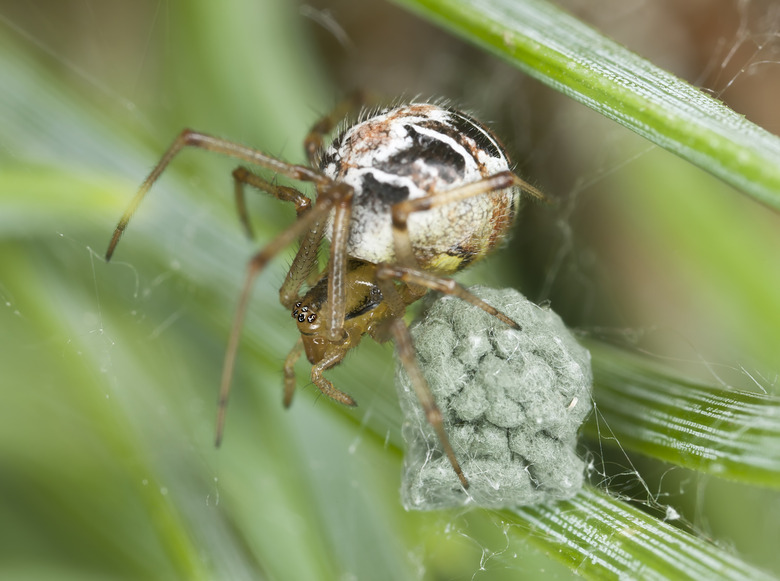How Do Spiders Mate?
Arachnophobes beware: if the sight of spiders with their many moving legs raises your blood pressure and makes you queasy or if the feel of spider webs gives you the heebie jeebies, you might really hate spider sex. If any aspect of the arachnid life displays just how diverse, strange and downright scary these animals are, it is definitely spider mating.
TL;DR (Too Long; Didn't Read)
**TL;DR (Too Long; Didn't Read)**
During spider mating, the male spider deposits sperm into a sperm web then draws that sperm into his pedipalps. He uses his pedipalps to insert the sperm into both the female spider's genital openings, or epigynum. The female stores the sperm inside her body and chooses which sperm she prefers to use to fertilize her eggs, before laying up to a thousand fertile eggs into a silk egg sac.
Spider Reproduction Basics
Spider Reproduction Basics
Between their fangs and their legs, male spiders have a set of appendages called pedipalps, which they use as reproductive organs. Prior to mating, a male spider builds a web called a sperm web and deposits sperm from the gonopore opening into the web. Then, through a process called sperm induction, the spider draws the sperm into its pedipalps. He will use these sperm-filled pedipalps to deposit his sperm inside both the genital openings of a female spider, called the epigynum, which are directly in front of her gonopore. Once completed, the sperm remains stored inside the female spider in specialized receptacles. This sperm fertilizes the spider's eggs as they pass through the oviduct before being laid via the gonopore into an egg sac made of silk, which may contain as many as a thousand eggs.
More Advanced Spider Sex
More Advanced Spider Sex
Of course, there is more to spider reproduction than just the bare bones mechanics of sperm meeting eggs, and, true to their creepy natures, spider sex is both strange and a bit horrifying. Most spiders engage in sexual cannibalism where one spider, usually the female of the species, kills and eats the other spider immediately after mating. Because female spiders can select which sperm fertilizes her eggs, this violent act may increase the odds of reproductive success for the male spider since the female spider might be too busy eating him to mate with another male. Some male spiders even choose to stick around for the murderous meal (of which they are the main course) to ensure their sperm persists.
Because spider mating is so dangerous, many species evolve elaborate ways to approach spider sex delicately. For example, some male spiders use mating dances or tapping on either the web or the ground to mollify the female spider before mating. Other spider suitors offer the female a gift of a tasty fly carefully wrapped in silk to distract her attention for mating; if a fly is unavailable, a sneaky male spider might even wrap up a pebble instead.
Once mating occurs, some male spiders have developed methods to improve their odds of reproductive success. Aside from allowing themselves to become a meal, some males tear off their pedipalps and leave them inside the female to serve as a plug to prevent other spiders from mating with her. Other spiders use a secretion to seal the female spider's genital openings for the same reason.
See You in Your Nightmares
See You in Your Nightmares
Any description of macabre spider mating would be remiss to forget what happens after successful reproduction. Approximately one to four weeks after laying, the egg sac tears open, releasing up to a thousand writhing baby spiders. Some spiderlings merely disperse on their scuttling feet while others use a single strand of silk to catch the air currents and balloon through the air. Still others, like the wolf spider, crawl onto their mother's back so that she becomes a squirming cluster of hundreds of tiny spiders that scatter in all directions if disturbed. Sweet dreams.
Cite This Article
MLA
Mayer, Melissa. "How Do Spiders Mate?" sciencing.com, https://www.sciencing.com/spiders-mate-4595717/. 23 August 2018.
APA
Mayer, Melissa. (2018, August 23). How Do Spiders Mate?. sciencing.com. Retrieved from https://www.sciencing.com/spiders-mate-4595717/
Chicago
Mayer, Melissa. How Do Spiders Mate? last modified March 24, 2022. https://www.sciencing.com/spiders-mate-4595717/
